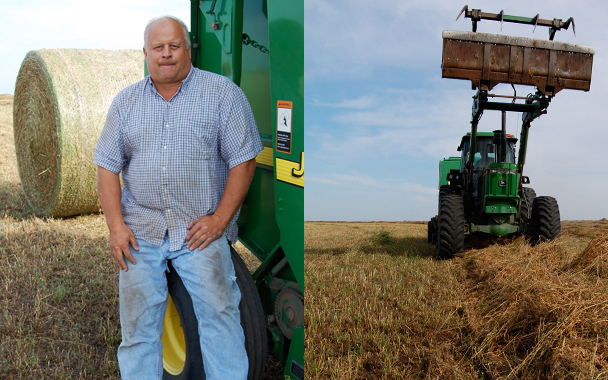Dale Hargens, Hand County, South Dakota
All over the Great Plains, farmers and ranchers are engaged in the American holiday ritual of mowing the lawn ... big time. First-cut alfalfa is ready for harvest and baling, and farmers like Dale Hargens have to be in the fields before sunrise, while the dew is still on the freshly mowed hay so that it will stick together in the bales. On June 30, Hargens had already been up early for two mornings. Then two tires on the mower went flat, and he lost a ball bearing in his baler. On the way to town, the transmission in his truck blew. In a week where mistakes are costly, his hay harvest was off to a bad start.
Mowing and baling alfalfa is not a “put-off-to-tomorrow” kind of task. Despite all the fits and starts, though, when Hargens climbs down from his tractor to meet me, he’s got a big grin on his face. Congress has mandated dramatic increases in corn-based ethanol, and he’s got six feet of subsoil moisture in the ground. He’s a fourth-generation farmer, and he can feel it: This is going to be his year. “It’s a perfect storm,” he tells me. “In a good way.”
Hargens has 1,000 acres of corn in the ground. At close of business last Monday, it was contracting at $6.92 a bushel. He’s also got a winter wheat crop, soybeans, and sunflowers, as well as 250 cow-calf pairs on 1,000 acres of pasture. He’ll feed them this week’s alfalfa next winter.
Old timers operate by two bits of wisdom. The first is, “Plant early, plant deep.” Hargens planted corn on April 22. It snowed twice while he was planting the field, but he got it in. The second bit of wisdom is, “You make a good crop if you are knee-high by the Fourth of July.” With rain and new genetically modified seeds, Hargens expected his corn to be chest high by the Fourth of July, but it isn’t. A cool spring rain slowed things down. But he spreads his hands apart like he’s telling a “big fish” story and says, “With the hot, humid weather we’re having, the corn will start growing four to six inches a day. Come back in a week, and you won’t even recognize it.” He’s got reason to smile. “I can spray for bugs. I can spray for fungus. The only thing that can wreck me now is hail.” So far he’s dodged a half dozen hailstorms that have thundered through his neighbors’ fields, but he went out and bought hail insurance last week. Turning the corner into midseason, he’s paid more than $50,000 in premiums to cover his crops against hit-or-miss storms.




 Pinterest
Pinterest


